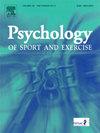All exercisers are passionate for exercise in some way: Taxometric evidence of the dimensionality of harmonious and obsessive passion for exercise
IF 3.1
2区 心理学
Q2 HOSPITALITY, LEISURE, SPORT & TOURISM
引用次数: 0
Abstract
The dualistic model of passion presents two important variables in the maintenance of physical exercise throughout life: harmonious passion and obsessive passion. Understanding whether the latent structure of these variables is better represented by classes (categorical) or factors (dimensional) can yield both theoretical and practical benefits. The objective of our study was to test, using taxometric analysis, whether these are dimensional latent variables (present in all exercisers, varying only in level) or categorical (present only in some exercisers). In a community sample of 1143 Brazilian exercisers with ages ranging from 18 to 71 years (M = 33.17; SD = 11.86), we conducted taxometric analysis using three non-redundant procedures at multiple base rates. Our results indicated the dimensionality of both harmonious and obsessive passion, which means that both are present, to some degree, in all exercisers. Evidence for harmonious passion was weaker due to high within-group correlations between the indicators. These findings can aid in the refinement of the construct and its measures, as well as in planning strategies to promote physical exercise by increasing levels of harmonious passion and preventing/treating exercise dependence through interventions aimed at reducing obsessive passion.
所有的锻炼者都在某种程度上对运动充满热情:对运动的和谐和痴迷的激情维度的分类证据。
激情的二元模型呈现出两个重要的变量:和谐激情和强迫性激情。了解这些变量的潜在结构是由类别(分类)还是因子(维度)更好地表示,可以产生理论和实践上的好处。我们研究的目的是通过分类分析来检验这些是维度潜在变量(存在于所有锻炼者中,仅在水平上变化)还是类别变量(仅存在于某些锻炼者中)。在1143名巴西锻炼者的社区样本中,年龄从18岁到71岁不等(M = 33.17;SD = 11.86),我们在多个基准率下使用三个非冗余程序进行分类分析。我们的结果显示了和谐激情和强迫性激情的维度,这意味着在某种程度上,所有锻炼者都存在这两种激情。和谐激情的证据较弱,因为指标之间的组内相关性较高。这些发现有助于完善该结构及其测量方法,也有助于规划策略,通过提高和谐激情水平来促进体育锻炼,并通过旨在减少强迫性激情的干预措施预防/治疗运动依赖。
本文章由计算机程序翻译,如有差异,请以英文原文为准。
求助全文
约1分钟内获得全文
求助全文
来源期刊
CiteScore
6.40
自引率
5.90%
发文量
172
审稿时长
69 days
期刊介绍:
Psychology of Sport and Exercise is an international forum for scholarly reports in the psychology of sport and exercise, broadly defined. The journal is open to the use of diverse methodological approaches. Manuscripts that will be considered for publication will present results from high quality empirical research, systematic reviews, meta-analyses, commentaries concerning already published PSE papers or topics of general interest for PSE readers, protocol papers for trials, and reports of professional practice (which will need to demonstrate academic rigour and go beyond mere description). The CONSORT guidelines consort-statement need to be followed for protocol papers for trials; authors should present a flow diagramme and attach with their cover letter the CONSORT checklist. For meta-analysis, the PRISMA prisma-statement guidelines should be followed; authors should present a flow diagramme and attach with their cover letter the PRISMA checklist. For systematic reviews it is recommended that the PRISMA guidelines are followed, although it is not compulsory. Authors interested in submitting replications of published studies need to contact the Editors-in-Chief before they start their replication. We are not interested in manuscripts that aim to test the psychometric properties of an existing scale from English to another language, unless new validation methods are used which address previously unanswered research questions.

 求助内容:
求助内容: 应助结果提醒方式:
应助结果提醒方式:


